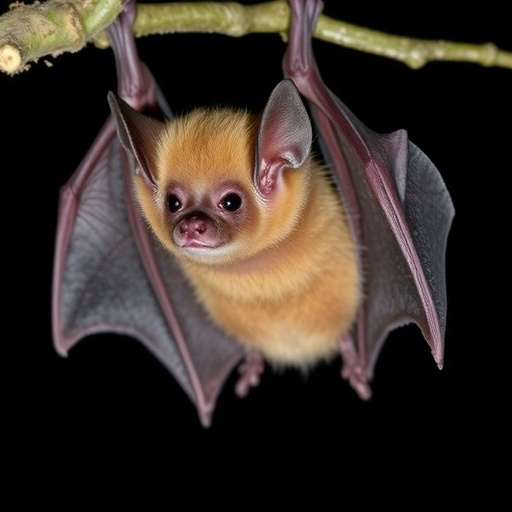In a landmark contribution to our understanding of virus ecology, researchers from the University of Oklahoma have published a striking new study in Communications Biology that reshapes the prevailing narrative around bats and their association with dangerous viral pathogens. Their work challenges the generalized belief that all bats act as reservoirs for viruses with the potential to cause epidemics, revealing instead a complex phylogenetic patchwork where viral epidemic potential is unevenly distributed among specific bat lineages.
Bats have long been identified as carriers of some of the most dreaded zoonotic viruses affecting human populations globally. They harbor viruses ranging from SARS-like coronaviruses and Marburg virus to Hendra and Nipah viruses, all noted for their capacity to inflict severe morbidity and mortality across species barriers. These pathogens are characterized by their high virulence, efficient transmissibility, and ability to incite outbreaks that strain public health infrastructure.
Yet, this broad-brush characterization obscures critical nuances. Bats are integral to ecosystems worldwide, providing irreplaceable services such as insect population control and plant pollination. In Oklahoma’s agricultural landscape, Mexican free-tailed bats exemplify this ecological utility by significantly reducing crop-damaging pest populations. Meanwhile, fruit bats play essential roles as pollinators, facilitating the reproduction of various flowering plants. These ecosystem services underscore why indiscriminate fears about bats pose risks to conservation and, consequently, broader ecological health.
Lead author Caroline Cummings, a doctoral candidate at the University of Oklahoma’s School of Biological Sciences, spearheaded the research leveraging cutting-edge machine learning algorithms to dissect bat-virus associations with unprecedented resolution. By integrating phylogenetic data and viral trait characteristics, the team identified distinct bat clades that disproportionately harbor viruses exhibiting high epidemic potential. Their methodology involved analyzing viral virulence and transmissibility metrics in relation to bat evolutionary lineages, uncovering patterns of co-evolution that predict virus-host specificity.
Cummings explained, “Our findings show that not all bats are equal viral reservoirs. Instead, only specialized groups within the bat phylogeny have evolved alongside viruses possessing high virulence and transmissibility. This co-evolution explains why these bats maintain a subclinical state, effectively tolerating viruses that would otherwise be highly pathogenic.”
This refined understanding holds profound implications for public health surveillance and zoonotic disease mitigation strategies. Traditional viral surveillance is fraught with logistical challenges, being time-consuming, resource-intensive, and costly. Pinpointing bat groups with elevated risks enables targeted sampling efforts, optimizing the allocation of surveillance resources and enhancing early outbreak detection capabilities. Such precise focus increases the likelihood of identifying potential spillover events before they escalate.
A further dimension of the research maps where these high-risk bat clades geographically overlap with zones experiencing intense habitat disruption and human encroachment. Anthropogenic activities — including deforestation, urban expansion, and agricultural intensification — compromise bat habitats, elevating contact rates between bats and humans. Moreover, habitat stress can impair bats’ immune competence, increasing viral shedding and the probability of zoonotic transmission events.
Cummings highlighted the dual role of habitat integrity, stating, “Protecting natural habitats supports bat health and stabilizes immune responses that keep viruses in check. Conservation is not just about protecting bats—it’s about reducing the risks of spillover that could ignite future pandemics.”
Senior author Dr. Daniel Becker, an assistant professor at the same institution, emphasized the project’s potential to recalibrate public and scientific discourse on zoonotic risks: “We need precision in how we talk about bats and viruses. Broad generalizations lead to fear-driven responses that may harm bat populations and ecosystems, ultimately backfiring on public health. Identifying high-risk groups and their spatial contexts allows us to minimize harmful human–bat interactions.”
Beyond public health and conservation, the insights gained from this study pave the way for exciting avenues in biomedical research. Understanding the unique immunological adaptations that enable certain bat species to coexist with highly virulent viruses without succumbing to disease could inspire the development of novel antiviral therapies and immune-modulating drugs. The molecular mechanisms underlying such viral tolerance remain largely enigmatic but represent a promising frontier in translational science.
Bats’ exceptional ability to harbor pathogenic viruses while maintaining resilience is hypothesized to stem from evolutionary pressures shaping their immune systems. Studying these adaptations could illuminate pathways for enhancing human antiviral defenses, offering therapeutic strategies that complement traditional vaccine and drug development efforts.
The meticulous phylogenetic mapping achieved through advanced computational techniques also exemplifies how interdisciplinary approaches are revolutionizing disease ecology. Integrating evolutionary biology, ecology, and machine learning sets a new standard for identifying zoonotic risks in complex wildlife reservoirs, transcending simplistic host-pathogen models.
As the global community grapples with increasing emergence of infectious diseases linked to wildlife, this study underscores the critical need for nuanced, evidence-based frameworks. It highlights how conservation efforts, wildlife health monitoring, and public health preparedness are deeply interconnected components in a holistic One Health strategy.
In sum, the University of Oklahoma’s research delineates a sophisticated portrait of bat-virus dynamics, revealing that viral epidemic potential is not a uniform trait dispersed across all bats but is instead concentrated within specific evolutionary clades. This paradigm shift enhances our capacity for targeted viral surveillance, informs conservation practices, and opens innovative pathways for therapeutic advancements — marking a significant leap forward in our fight against emerging infectious diseases.
Subject of Research: Viral epidemic potential across bat phylogeny and its implications for zoonotic disease transmission
Article Title: Viral epidemic potential is not uniformly distributed across the bat phylogeny
News Publication Date: 30-Oct-2025
Web References:
10.1038/s42003-025-08929-5
Keywords: Viruses, Viral infections, Public health, Infectious diseases, Animal diseases, Animal taxonomies, Clades
Tags: bat lineage viral potentialbat species viral riskbats and human healthbats as pollinatorsbiodiversity and batsfruit bats ecological rolesMexican free-tailed batsphylogenetic patchwork of batspublic health impact of batsviral pathogens in batsvirus ecology studyzoonotic virus carriers





